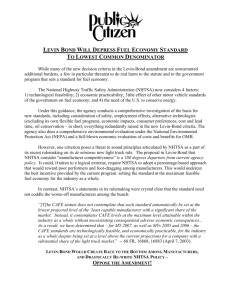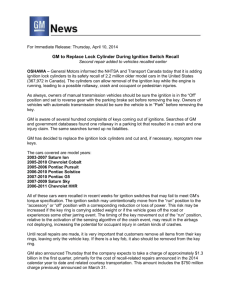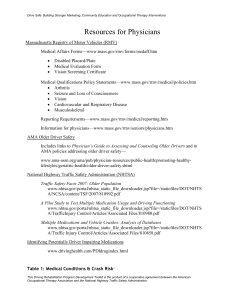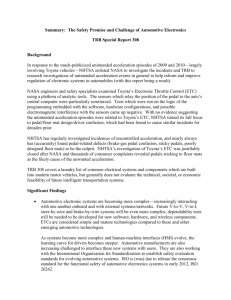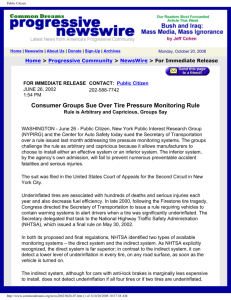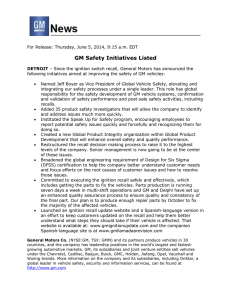the committee on energy and commerce
advertisement
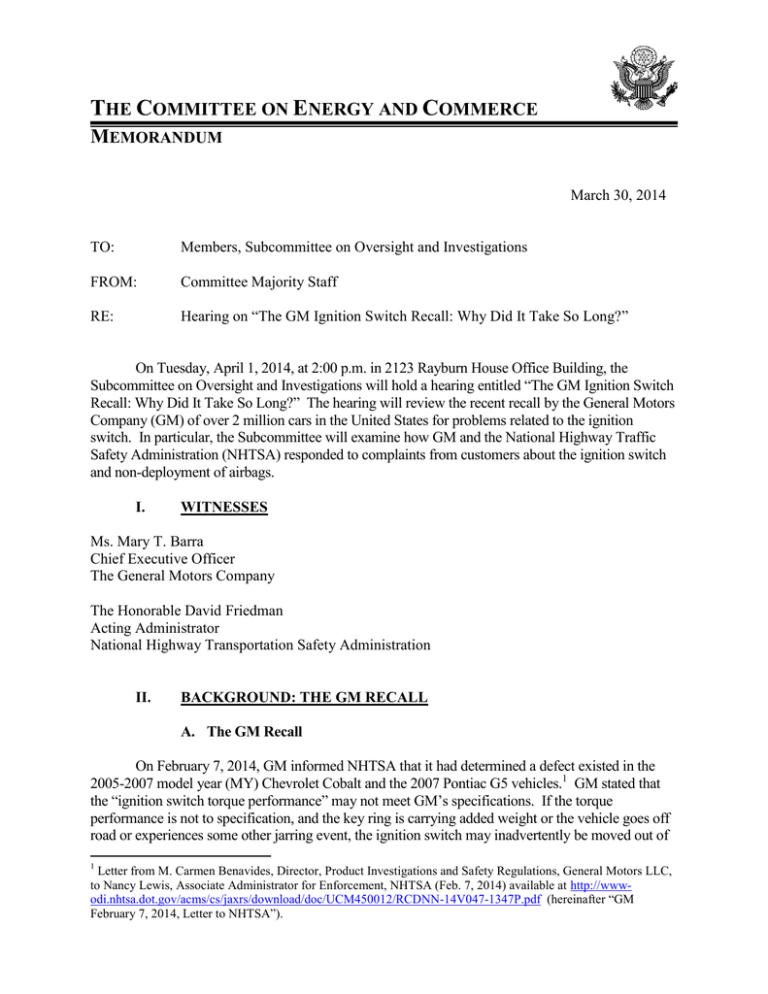
THE COMMITTEE ON ENERGY AND COMMERCE MEMORANDUM March 30, 2014 TO: Members, Subcommittee on Oversight and Investigations FROM: Committee Majority Staff RE: Hearing on “The GM Ignition Switch Recall: Why Did It Take So Long?” On Tuesday, April 1, 2014, at 2:00 p.m. in 2123 Rayburn House Office Building, the Subcommittee on Oversight and Investigations will hold a hearing entitled “The GM Ignition Switch Recall: Why Did It Take So Long?” The hearing will review the recent recall by the General Motors Company (GM) of over 2 million cars in the United States for problems related to the ignition switch. In particular, the Subcommittee will examine how GM and the National Highway Traffic Safety Administration (NHTSA) responded to complaints from customers about the ignition switch and non-deployment of airbags. I. WITNESSES Ms. Mary T. Barra Chief Executive Officer The General Motors Company The Honorable David Friedman Acting Administrator National Highway Transportation Safety Administration II. BACKGROUND: THE GM RECALL A. The GM Recall On February 7, 2014, GM informed NHTSA that it had determined a defect existed in the 2005-2007 model year (MY) Chevrolet Cobalt and the 2007 Pontiac G5 vehicles.1 GM stated that the “ignition switch torque performance” may not meet GM’s specifications. If the torque performance is not to specification, and the key ring is carrying added weight or the vehicle goes off road or experiences some other jarring event, the ignition switch may inadvertently be moved out of 1 Letter from M. Carmen Benavides, Director, Product Investigations and Safety Regulations, General Motors LLC, to Nancy Lewis, Associate Administrator for Enforcement, NHTSA (Feb. 7, 2014) available at http://wwwodi.nhtsa.dot.gov/acms/cs/jaxrs/download/doc/UCM450012/RCDNN-14V047-1347P.pdf (hereinafter “GM February 7, 2014, Letter to NHTSA”). Majority Memorandum for April 1, 2014, Oversight and Investigations Subcommittee Hearing Page 2 the run position.2 GM explained that depending on the time the ignition moved out of the “run” position the airbags of the affected vehicles would not deploy. The recall was announced on February 10, 2014, and applied to 619,122 vehicles. Two weeks later, GM expanded the recall on February 25, 2014, to include an additional 748,024 vehicles: the 2006-2007 MY Chevrolet HHR, the 2006-2007 MY Pontiac Solstice, the 2003-2007 MY Saturn Ion, and the 2007 MY Saturn Sky Vehicles.3 In its recall notices, GM stated that it is “very important that customers remove all items from their key rings, leaving only the vehicle key. The key fob . . . should also be removed from the key ring.”4 In a March 17, 2014, notice to GM dealers, GM stated that they expected the initial supply of new ignition switch parts would be available on April 7, 2014.5 Last Friday, March 28, 2014, GM again expanded the ignition switch recall to cover all model years of the Chevrolet Cobalt and HHR, the Pontiac G5 and Solstice, and the Saturn Ion and Sky in the United States. GM states that its reason for expanding the recall was that faulty switches may have been used in these later models. GM stated that it is “unaware of any reports of fatalities with this group of vehicles where a frontal impact occurred, the front air bags did not deploy and the ignition is in the ‘accessory’ or ‘off’ position.”6 This second expansion of the ignition switch recall covers an additional 824,000 vehicles in the U.S., bringing the number of recalled vehicles to 2,191,146. B. The TREAD Act In the wake of the Firestone tire recalls involving Ford Explorer vehicles, Congress in 2000 enacted the Transportation Recall Enhancement, Accountability, and Documentation (TREAD) Act.7 The TREAD Act amended Title 49 of the United States Code to require Early Warning Reporting (EWR) by manufacturers.8 EWR reports are filed quarterly.9 Manufacturers must file a report on each incident involving one or more deaths or injuries that is identified in a claim against the manufacturer and which alleges that the injury or death was caused by a possible defect.10 In 2 Id. Letter from M. Carmen Benavides, Director, Product Investigations and Safety Regulations, General Motors LLC, to Nancy Lewis, Associate Administrator for Enforcement, NHTSA (Feb. 25, 2014) available at http://wwwodi.nhtsa.dot.gov/acms/cs/jaxrs/download/doc/UCM450732/RCDNN-14V047-7510.pdf (hereinafter “GM February 24, 2014, Letter to NHTSA”). 4 See, e.g., GM February 7, 2014, Letter to NHTSA; GM February 24, 2014, Letter to NHTSA; and Letter from M. Carmen Benavides, Director, Product Investigations and Safety Regulations, General Motors LLC, to Nancy Lewis, Associate Administrator for Enforcement, NHTSA (Mar. 11, 2014) available at http://wwwodi.nhtsa.dot.gov/acms/cs/jaxrs/download/doc/UCM451430/RCDNN-14V047-9346P.pdf (hereinafter “GM March 11, 2014, Letter to NHTSA”). 5 Memorandum from GM Customer Care and Aftersales to All General Motors Dealers (Mar. 17, 2014) available at http://www-odi.nhtsa.dot.gov/acms/cs/jaxrs/download/doc/UCM452894/RCMN-14V047-3409.pdf . 6 Press Release, General Motors, GM Moves to Secure Recalled Ignition Switches (Mar. 28, 2014) available at http://media.gm.com/media/us/en/gm/news.detail.html/content/Pages/news/us/en/2014/mar/0328-ignitionservice.html . 7 Pub. L. 106-414 (2000). 8 See 49 U.S.C § 30116 (l) and (m); 49 C.F.R. § 579.21. 9 See 49 C.F.R. § 570.4 (c). 10 See 49 U.S.C. § 30166(m)(3)(A)(i). 3 Majority Memorandum for April 1, 2014, Oversight and Investigations Subcommittee Hearing Page 3 addition, for the incidents involving death or injury, the manufacturer must report certain information about the vehicles involved, including the make, model, and Vehicle Identification Number (VIN), and identify each system or component that allegedly contributed to the incident.11 EWR also includes aggregate data on the number of property damage claims, consumer complaints, warranty claims, and field reports for certain vehicle systems.12 Copies of field reports must be provided each quarter.13 In addition to the quarterly reports, TREAD requires that manufacturers notify NHTSA about recalls and safety campaigns in foreign countries within five working days if the vehicle is “identical or substantially similar” to a vehicle in the United States.14 Manufacturers must submit within five working days of the end of the month in which they were issued certain communications with dealers or customers, including bulletins, notices, consumer advisories, and warranty communications.15 TREAD also established certain safety standards for tires, tire pressure monitoring systems, and rollover stability. Further, upon enactment, the law set civil penalties of up to $5,000 per motor vehicle per day with a maximum penalty of $15 million for all violations or refusals to comply with a NHTSA regulation. NHTSA adjusted those penalties in late 2012 to $7,000 for each violation or a total of $17.35 million for all violations.16 Those maximum penalties were increased again when President Obama signed into law the “Moving Ahead for Progress in the 21st Century Act” which increased the maximum civil penalty for all violations of motor vehicle safety rules to $35 million.17 The law contained factors the Secretary of Transportation must consider when determining a penalty amount, as well as a directed rulemaking interpreting such penalty factors. C. NHTSA’s Role An agency within the Department of Transportation (DOT), NHTSA was established in 1970 by the Highway Safety Act of 1970. According to its website, NHTSA is responsible for “reducing deaths, injuries and economic losses resulting from motor vehicle crashes.” Within NHTSA, the Office of Defects Investigation (ODI) is responsible for reviewing customer complaint data as well as EWR from manufacturers to determine if an investigation of a possible safety defect should be conducted. Customer complaints may be submitted to NHTSA by letter, phone, or to a database located at www.safercar.gov. In a briefing with Committee staff on March 10, 2014, NHTSA officials estimated that the agency receives 45,000 to 55,000 complaints a year to its database, although not all complaints submitted to the database refer to or implicate 11 See 49 C.F.R. § 579.21 (b)(2). The systems or components specified in the regulation include steering system, suspension system, service brake system, parking brake, engine and engine cooling system, fuel system, power train, electrical system, exterior lighting, visibility, air bags, seat belts, structure, latch, vehicle speed control, tires, wheels, seats, fire, and rollover. The manufacturer can also indicate that the component or system identified in the claim is not covered by the statute or that no component or system was specified in the claim. 12 See 49 C.F.R. § 579.21 (c). Those systems are listed in footnote 5. 13 See 49 U.S.C. 30166(l); 49 C.F.R. § 579.21(d). 14 49 C.F.R. § 579.11 and §479.12. 15 See 49 C.F.R. § 579.5 16 See 49 C.F.R. § 578.6 (a) available at http://www.gpo.gov/fdsys/pkg/FR-2012-11-27/pdf/2012-28694.pdf . 17 See Pub. L. 122-141 (2012) available at http://www.gpo.gov/fdsys/pkg/PLAW-112publ141/pdf/PLAW112publ141.pdf . Majority Memorandum for April 1, 2014, Oversight and Investigations Subcommittee Hearing Page 4 safety.18 NHTSA states that each complaint in its database is read by an ODI reviewer. This is referred to as a “Level I” review. Certain complaints then receive a “Level II review” or are sent to an investigator where additional follow-up is conducted to determine the facts of a complaint. To determine whether a potential safety-related defect exists, NHTSA opens an Initial Evaluation (IE). A referral to a NHTSA investigative division to open a defect investigation requires the approval of the ODI director. An ODI defect investigation has two phases. The first is a Preliminary Evaluation (PE). During this phase, the agency may request information from the manufacturer in order to determine whether more analysis is need. The second is an Engineering Analysis (EA). The EA is a more extensive investigation, and may involve additional requests to the manufacturer, other manufacturers, and testing and inspection of vehicles. In addition to reviewing customer complaints and EWR, NHTSA also conducts Special Crash Investigations. NHTSA currently contracts with three different firms to perform these investigations. NHTSA may either assign a specific crash or the contractor can propose a case to NHTSA for investigation; in most instances, the investigations are assigned by NHTSA. In a briefing with Committee staff, NHTSA Special Crash Investigations (SCI) Program officials estimated that the office performs 100-125 investigations a year, depending on the complexity of the cases.19 The purpose of NHTSA’s SCI Program is not to identify a defect or determine the cause of a crash. Instead, the purpose of these investigations is to document the condition of the vehicle as it was found after the crash and tie the injuries suffered by its occupants to the vehicle’s safety systems and components so that vehicle performance is improved.20 NHTSA officials explained during a briefing with Committee staff that the SCI Program often focuses its investigations on new and emerging automobile technologies. For example, NHTSA SCI Program officials explained that the office has been closely involved in investigations of airbag systems, in particular, the adoption of advanced systems in vehicles beginning in 2004 in order to meet the requirements of Federal Motor Vehicle Safety Standard 208.21 The SCI Program has performed over 1,200 airbag investigations. Contractors for the SCI Program performed three investigations of crashes in the Chevrolet Cobalt where the air bags did not deploy. These crashes occurred in July 2005, October 2006, and April 2009. Additional information about these investigations is provided in Part III, below. III. THE COMMITTEE’S INVESTIGATION On March 10, 2014, the Committee announced that it would conduct a bipartisan investigation of the GM ignition switch recall. On March 11, 2014, Committee members sent letters to GM and NHTSA requesting certain documents and information about the GM recall. 18 NHTSA Office of Defects Investigation, Briefing to Committee Staff (Mar. 24, 2014) (hereinafter “NHTSA ODI Briefing”). 19 NHTSA Special Crash Investigations Program, Briefing to Committee Staff (Mar. 24, 2014) (hereinafter “NHTSA SCI Briefing”). 20 See id. 21 See id. Majority Memorandum for April 1, 2014, Oversight and Investigations Subcommittee Hearing Page 5 Since sending these requests, the Committee has received and reviewed over 200,000 pages of documents from GM and approximately 6,000 pages from NHTSA. Committee staff received a briefing from GM officials on March 18, 2014. Committee staff has received three briefings from various offices within NHTSA, including a briefing from NHTSA ODI officials on March 10, from SCI Program staff on March 24, and a demonstration of NHTSA ODI software on March 24. In addition, Committee staff was briefed by two GM suppliers, Delphi (the ignition switch supplier for the recalled vehicles) and Continental Corporation (the supplier of the airbag Sensing Diagnostic Module, or SDM, for the recalled GM vehicles). Finally, Committee staff conducted briefings with employees of the two NHTSA contractors that performed the SCI of Chevrolet Cobalts for nondeployment of airbags, Calspan Corporation and Indiana University Transportation Research Center. Set forth below is a timeline of key facts and events leading up to the GM ignition switch recall. It is important to note that the Committee’s investigation is ongoing, and the Committee expects to receive additional documents from both GM and NHTSA and to conduct additional interviews. While Committee staff now has a better understanding of the chronology leading up to the recall, until additional documents have been received, the information in the timeline is preliminary and incomplete. This information is presented to inform Committee members and serve as a basis for additional inquiry during the April 1, 2014, hearing before the Subcommittee. 22 Late 1990s/Early 2000s: GM and supplier Eaton Mechatronics finalized the specifications for the ignition switch for the Saturn Ion.22 Eaton Corporation sold its Vehicle Switch/Electronic Division to Delphi Automotive Systems (“Delphi”) on March 31, 2001. 2001: A pre-production report for the MY 2003 Saturn Ion identified issues with the ignition switch.23 In a section entitled “Root Cause Summary,” the report stated that the “two causes of failure” were “[l]ow contact force and low detent plunger force.”24 The report stated that a design change resolved the problem.25 February 2002: Delphi, GM’s ignition switch supplier for the recalled vehicles, submitted a Production Part Approval Process (PPAP) document for the switch. During a briefing, Delphi officials told Committee staff that GM approved the PPAP even though sample testing of the ignition switch torque was below the original specifications set by GM.26 November 2004: GM opened an engineering inquiry, Problem Resolution Tracking System N172404 (“2004 PRTS”), to examine the complaint “vehicle can be keyed off with knee while driving” in a 2005 Chevrolet Cobalt.27 Delphi, Briefing to Committee Staff (March 27, 2014) (hereinafter “Delphi Briefing”). See Report/Complaint regarding “Electrical Concern” Opened July 31, 2001, GMHEC000001980-1990. GM referenced the report in the chronology attached to the GM March 11, 2014, Letter to NHTSA. 24 Id. at GMHEC000001986. 25 The chronology attached to the GM March 11, 2014, letter to NHTSA states that the 2001 Saturn Ion ignition switch report was uncovered in February 2014 when GM Was conducting “additional analyses” of the Saturn Ion, HHR, Solstice, and Sky vehicles. 26 Delphi Briefing. 27 See Problem Resolution Tracking System N172404, originated Nov. 19, 2004, GMHEC000001727-41 (hereinafter “2004 PRTS”). 23 Majority Memorandum for April 1, 2014, Oversight and Investigations Subcommittee Hearing Page 6 28 o February 2005: As part of the 2004 PRTS, GM engineers met to consider possible solutions to address low key torque. The PRTS document indicates that the engineers considered increasing or changing the ignition switch “torque effort,” but were advised by the ignition switch engineer that it is “close to impossible to modify the present ignition switch” as the switch is “very fragile and doing any further changes will lead to mechanical and/or electrical problems.”28 The 2004 PRTS document indicates that potential solutions were developed for consideration. After internal evaluations, engineers were directed to look into a key slot change as a “containment,” including developing cost and timing estimates.29 o March 2005: The Cobalt Program Engineering Manager’s (PEM) “directive” was to close the 2004 PRTS “with no action.”30 The main reasons cited for the decision were “lead-time for all solutions is too long,” “tooling cost and piece price are too high,” and “[n]one of the solutions seems to fully countermeasure the possibility of the key being turned (ignition turned off) during driving.”31 The PRTS entry concluded that “none of the solutions represents an acceptable business case.”32 The documents produced to the Committee to date do not explain the criteria for an “acceptable business case” and how the decision was made in this case.33 May 2005: A new Problem Resolution Tracking System (PRTS N182276 or “2005 PRTS”) is opened to examine the 2005 Chevrolet Cobalt after a customer complaint that the “vehicle ignition will turn off while driving.”34 The 2005 PRTS document noted that the same issue was addressed in the 2004 PRTS (N172404) and closed, but “[d]ue to the level of buyback activity that is developing in the field , Brand Quality requests that the issue be reopened.”35 One proposed solution was changing the key ring slot to a hole and using a smaller key ring.36 In the chronology attached to the GM February 24, 2014, Letter to NHTSA, GM acknowledges that this proposal was approved but later cancelled. July 2005: A 2005 Chevrolet Cobalt crashed in Maryland, killing the driver. On August 15, 2005, NHTSA Special Crash Investigations Program assigned Calspan to conduct a SCI, which found that the frontal airbag system did not deploy. The SDM data indicated that the “vehicle power mode status” was in “Accessory.”37 August 2005: NHTSA begins the Special Crash Investigation of the July 2005 accident. Documents produced to the Committee indicate that GM reported this crash in its Third 2004 PRTS at GMHEC000001733. 2004 PRTS at GMHEC000001734. 30 2004 PRTS at GMHEC000001735. 31 Id. 32 Id. 33 Id. 34 See Problem Resolution Tracking System N182276, originated May 17, 2005, GMHEC000001742-54 (hereinafter “2005 PRTS”). 35 Id. at GMHEC000001743. 36 Id. at GMHEC000001750. 37 Calspan Corporation Crash Data Research Center, Calspan On-site Air Bag Non-deployment Investigation Case No: CA05-049, Vehicle: 2005 Chevrolet Cobalt (July 2005) (hereinafter “2005 SCI Report”). 29 Majority Memorandum for April 1, 2014, Oversight and Investigations Subcommittee Hearing Page 7 38 Quarter 2005 EWR to NHTSA. NHTSA responded to the report on March 1, 2006, and requested certain information which GM provided.38 December 2005: GM issued a Service Bulletin 05-02-35-007 with the subject “Information on Inadvertent Turning Off of Key Cylinder, Loss of Electrical System and No DTCs” for the Chevrolet Cobalt and HHR, Saturn Ion, and Pontiac Solstice and Pursuit (Canada only).39 In the GM February 24, 2014 chronology, GM states that the 2005 PRTS process led to this bulletin. The Service Bulletin informed the dealer of the identified issue with the ignition and recommended potential remedies including removing heavy items from key rings. According to the February 24, 2014, chronology submitted to NHTSA, “GM concluded in December 2005 that the service bulletin and field service campaign were the appropriate response to the reported incidents, given that the car’s steering and braking systems remained operational even after a loss of engine power, and the car’s engine could be restarted by shifting the car into either neutral or park.”40 April 26, 2006: A GM design engineer responsible for the ignition switch in the recalled vehicles signed a form entitled “General Motors Commodity Validation Sign-Off” authorizing Delphi to implement changes in the ignition switch.41 The form explained that a “new detent plunger . . . was implemented to increase torque performance in the switch.”42 According to Delphi officials, sample testing prior to this approval suggested a significant increase in torque performance but the values were still below GM’s original specifications.43 The modified ignitions began to appear in 2007 model year vehicles for all models affected by the recall. In its chronology submitted to NHTSA on February 24, 2014, GM acknowledged that the new ignition switch, however, was not reflected in a corresponding change in part number.44 October 2006: A 2005 Chevrolet Cobalt crashes in Wisconsin, killing the front right and back right passengers. NHTSA SCI Program assigned Indiana University Transportation Research Center to investigate the crash, and the contractor inspected the vehicle on November 6, 2006.45 GM reported this crash in its Fourth Quarter 2006 EWR filing.46 On May 7, 2007, NHTSA requested additional information from GM which it provided on June 7, 2007.47 See Letter from Christina Morgan, Chief, Early Warning Division, Office of Defects Investigation, to Gay P. Kent, Director, General Motors Corp. (Mar. 1, 2006) and Letter to Christina Morgan from Gay P. Kent, Director, Product Investigations (Apr. 6, 2006), GMHEC00198137-198210. See also GMHEC00197893. 39 Service Bulletin 05-02-35-007, “Information on Inadvertent Turning Off of Key Cylinder, Loss of Electrical System and No DTCs,” (October 2006) at GMHEC000000001. 40 GM March 11, 2014, Letter to NHTSA, attached chronology. 41 General Motors Commodity Validation Sign-Off (Apr. 26, 2006), GMHEC000003201. 42 Id. 43 Delphi Briefing (Mar. 27, 2014). 44 GM February 24, 2014, Letter to NHTSA, attached chronology. 45 Indiana University Transportation Research Center, On-site Air Bag Non-deployment Investigation Case No: IN06-033, Vehicle: 2005 Chevrolet Cobalt (Oct. 2006) (hereinafter “2006 SCI Report”). Id. at ii. 46 See Letter from Christina Morgan, Chief, Early Warning Division, Office of Defects Investigation, to Gay P. Kent, Director, General Motors Corp. (May 7, 2007) and Letter to Christina Morgan from Gay P. Kent, Director, Product Investigations (June 7, 2007), GMHEC00198410-198414. 47 See id. See also GMHEC00197898. Majority Memorandum for April 1, 2014, Oversight and Investigations Subcommittee Hearing Page 8 48 October 2006: GM updated the December 2005 Service Bulletin (05-02-35-007) to include additional models and model years: the 2007 Saturn Ion and Sky, 2007 Chevrolet HHR, and 2007 Pontiac Solstice and G5. As a result of the Service Bulletins, GM provided key inserts to 474 customers who brought their vehicles to the dealer for service.48 March 2007: NHTSA and GM met to discuss occupant restraint systems.49 To date, the Committee has received limited documentation associated with this meeting. GM’s February 24 chronology indicates that a NHTSA representative informed GM about a July 29, 2005 fatal crash. It appears this is the same crash that was the subject of the SCI. After the meeting, GM began tracking front impact crashes involving Cobalts where the air bags did not deploy in order to track similarities in the incidents. GM identified 10 incidents by the end of 2007. In four cases the ignition had moved into the “accessory” position. Comparable information was unavailable for the Saturn Ion because the SDM sensors installed in these vehicles did not record whether the engine was running.50 April 25, 2007: Indiana University submitted its draft of the 2006 SCI to the NHTSA SCI Program. The SCI report stated that the “crash is of special interest because the vehicle was equipped with . . . dual state air bags that did not deploy.”51 The SCI report concluded that the airbags did not deploy “as a result of the impact with the clump of trees, possibly due to the yielding nature of the tree impact or power loss due to the movement of the ignition switch just prior to impact.”52 The event data recorder (EDR) for the vehicle indicated that the power node status was “accessory” at the time of impact.53 The report also noted that the investigation revealed that contact with the ignition switch could result in “engine shut down and loss of power,” and cited the service bulletin issued on October 25, 2006. The report stated that it was unclear what role “if any” the ignition switch issue played in the non-deployment of the airbags.54 August 2007: GM met with its SDM supplier, Continental, to review SDM data from a crash of a 2005 Chevrolet Cobalt where the airbags failed to deploy.55 September 2007: The Chief of the Defects Assessment Division (DAD) within ODI emailed other ODI officials and proposed an investigation of “frontal airbag nondeployment in the 2003-2006 Chevrolet Cobalt/Saturn Ion.”56 The Chief of the Defects Assessment Division went on to state that the “issue was prompted by a pattern of reported non-deployments in VOQ [Vehicle Owners’ Questionnaire] complaints that was first observed in early 2005. Since that time, [the Defects Assessment Division] has followed up on the complaints, enlisted the support of NCSA’s Special Crash Investigations (SCI) team, discussed the matter with GM, and received a related EWD See Service Bulletin 05-02-35-007, “Information on Inadvertent Turning Off of Key Cylinder, Loss of Electrical System and No DTCs,” (October 2006, revised) at GMHEC000000002. 49 GM February 24, 2014, Letter to NHTSA, attached chronology. 50 Id. 51 2006 SCI Report. 52 Id. at ii. 53 Id. at 7. 54 Id. 55 See Continental Automotive Systems US, Inc., Field Event Analysis Report, GMHEC00003143-3153. 56 Email from Chief of Defects Assessment Division, ODI, to NHTSA staff (Sept. 05, 2007, 4:54:16 PM), NHTSA Bates NHTSA-HEC-004491. Majority Memorandum for April 1, 2014, Oversight and Investigations Subcommittee Hearing Page 9 57 Referral. Notwithstanding GM’s indications that they see no specific problem pattern, DAD perceives a pattern of non-deployments in these vehicles that does not exist in their peers . . . .”57 November 15, 2007: ODI IE panel reviewed the proposal to open an investigation into non-deployment of airbags in 2003-2006 Cobalts and Ions. A PowerPoint presentation prepared by the DAD and dated November 17, 2007, states that its review was prompted by 29 Complaints, 4 fatal crashes, and 14 field reports.58 During a briefing with Committee staff, ODI officials explained that the panel did not identify any discernable trend and decided not to pursue a more formal investigation.59 February 2009: GM opened another investigation into the ignition resulting in a redesign of the ignition key for model year 2010 Cobalt.60 April 2009: A 2005 Chevrolet Cobalt crashed in Pennsylvania, killing the Cobalt driver and front-seat passenger. NHTSA SCI Program assigned the Calspan Crash Data Research Center to investigate the crash, and the contractor inspected the vehicle on April 6 and 7, 2009.61 May 15, 2009: GM again met with its SDM supplier, Continental, and requested that Continental download SDM data from a 2006 Chevrolet Cobalt accident where the airbags failed to deploy.62 February 2010: Calspan Crash Data Research Center submitted its 2009 SCI Report, finding that the airbags did not deploy at the time of the crash and that the “cause of the air bag non-deployment in this severe crash could not be determined.”63 The data from the Cobalt’s SDM indicated that the Vehicle Power Mode Status was in “Accessory.”64 2010: ODI again considered Cobalt trend information on non-deployment but determined the data did not show a trend. August 2011: GM initiated a Field Performance Evaluation (FPE)65 to examine a group of frontal impact crashes involving the 2005-2007 Chevrolet Cobalt and the 2007 Pontiac G5 and airbag non-deployment. The FPE included a review of information related to the Ion, HHR and Solstice.66 Id. Defects Assessment Division, DAD Panel (Nov. 17, 2007) at NHTSA-HECC-004462-4483. 59 NHTSA ODI Briefing. 60 GM February 24, 2014, Letter to NHTSA, attached chronology at 2. 61 Calspan Corporation Crash Data Research Center, Calspan On-site Air Bag Non-deployment Investigation SCI Case No: CA09022, Vehicle: 2005 Chevrolet Cobalt (April 2009) (hereinafter “2009 SCI Report”). 62 See Continental Automotive Systems US, Inc., Field Event Analysis Report, GMHEC00003129-3142. 63 2009 SCI Report at 9. 64 Id. (SDM data report, attached to 2009 SCI Report). 65 See GM March 11, 2014 Letter to NHTSA, attached chronology. The FPE involves several steps. An investigation is conducted by Field Performance Assessment Engineers (FPAE) to ascertain the technical issues. Their analysis and proposed solutions are presented to the Field Product Evaluation Recommendation Committee (FPERC). Based on their review, the FPERC’s recommendations are presented to the Executive Field Action Decision Committee (EFADC). The EFADC is responsible for deciding on a course of action. 66 According to GM, this examination included “…reviewing data relating to complaints of stalling in the Ion for all model years; reviewing data relating to crashes involving Ions from certain model years in which airbags had not deployed; testing the torque performance of ignition switches from salvage yard vehicles, including Ions, HHRs, Cobalts and G5s (but not Solstice or Sky vehicles); measuring the difference among a wide variety of GM vehicles in the distance between a driver's knee and the ignition; and studying vehicles' different steering columns and 58 Majority Memorandum for April 1, 2014, Oversight and Investigations Subcommittee Hearing Page 10 May 2012: GM engineers tested the torque performance of 44 vehicles across a range of make and model years. Results revealed that the majority of vehicles tested from model years 2003 to 2007 exhibited torque performance at or below 10 Newton centimeters (Ncm), below the original specifications established by GM. The results also revealed a shift in torque performance beginning in MY2007 vehicles built late in 2006 and all subsequent model years. The torque performance for these vehicles ranged from just below 15 Ncm to 20Ncm. At the time, GM engineers could not explain the shift or discrepancies in torque performance.67 September 2012: A GM Field Performance Assessment Engineer emailed a GM Red X Engineer to request assistance in examining the changes between the 2007 and 2008 Chevrolet Cobalt Models.68 Based on a briefing with GM, Committee staff’s understanding is that GM Red X engineers are assigned to find the root cause of engineering or technical problems. April 2013: GM learned there was a difference in the torque performance of a GM service part ignition switch purchased after 2010 compared to the original ignition switch installed in a 2005 Cobalt.69 In response, GM hired an outside engineering firm to conduct a thorough ignition switch investigation. The external expert concluded that ignition switches installed in early model Cobalt and Ion vehicles did not meet GM’s torque specification and that a change to the switch made several years later provided a likely explanation for the variance in torque performance. 70 Data within the external report also indicated that vehicles with the modified ignition switch exhibited torque performance consistent with GM’s design specification.71 October 2013: GM received documentation from Delphi demonstrating that a change to the ignition switch in the Cobalt and other vehicles was made in April 2006.72 December 2013: The Field Performance Assessment Engineer presented the results of their analysis to the Field Product Evaluation Recommendation Committee (FPERC) and the Executive Field Action Decision Committee (EFADC).73 o December 17, 2013: The EFADC met to review the findings. Questions were raised at the meeting that prompted additional analysis. January 31, 2014: A second EFADC meeting was convened and resulted in a decision to conduct a safety recall of model year 2005-2007 Chevrolet Cobalt and Pontiac G5 vehicles.74 At the time, the EFADC was only asked to consider a recall of these vehicles.75 February 2014: Additional analysis was performed of data related to the Saturn Ion, Chevrolet HHR, and Pontiac Solstice and Sky vehicles. This analysis revealed earlier shrouds, including those of the Ion and the Cobalt.” GM March 11, 2014, Letter to NHTSA, attached chronology at 3. 67 Id. at 4. See also GMHEC000221427. 68 Email from GM Field Performance Assessment Engineer to GM Red X Team Engineer (Sept. 6, 2012, 1:29:14 PM), GMHEC000136204. 69 GM March 11, 2014, Letter to NHTSA, attached chronology at 4. 70 Id. 71 See GMHEC000003156-3180. 72 Id. at 5. 73 Id. 74 Id. 75 Id. Majority Memorandum for April 1, 2014, Oversight and Investigations Subcommittee Hearing Page 11 IV. reports of concerns with the ignition switch in Ion vehicles (noted earlier in timeline).76 February 13, 2014: GM announced a recall of 2005-2007 model year Chevrolet Cobalt and Pontiac G5 vehicles to address a fault with the ignition switch that may permit the key to inadvertently turn to the “off” or “accessory” position, resulting in a loss of power to the engine and many electrical components in the vehicle. February 24, 2014: GM submitted a detailed timeline to NHTSA pertaining to the Cobalt and Pontiac G5 recall. February 24, 2014: GM convened another EFADC meeting to review additional analysis related to the Saturn Ion and Sky, Chevrolet HHR, and Pontiac Solstice. The EFADC ordered a safety recall for certain model years of these vehicles.77 February 25, 2014: GM expanded the recall to include additional 2003-2007 model year vehicles. These include the MY 2003-2007 Saturn Ion, MY 2006-2007 Chevrolet HHR and Pontiac Solstice, and MY 2007 Saturn Sky. As a result of this expansion, the total number of vehicles subject to the recall rose to approximately 1.6 million worldwide, including more than 1.3 million in the United States. March 4, 2014: NHTSA opened Timeliness Query TQ14-001 “to evaluate the timing of GM’s defect decisionmaking and reporting of the safety defect to NHTSA.” March 11, 2014: GM submitted a detailed timeline to NHTSA related to the subsequent recall of the Saturn Ion, Saturn Sky, Chevrolet HHR and Pontiac Solstice. March 21, 2014: Transportation Secretary Anthony Foxx asked the Department of Transportation Inspector General to conduct an audit to determine whether federal regulators responded quickly enough to evidence of potential defects in GM vehicles. March 28, 2014: GM again expanded the ignition switch recall to cover all model years of the Chevrolet Cobalt and HHR, the Pontiac G5 and Solstice, and the Saturn Ion and Sky in the United States. This second expansion of the ignition switch recall covers an additional 824,000 vehicles in the U.S., bringing the number of recalled vehicles to 2,191,146. ISSUES The following issues may be examined at the hearing: 76 77 Why did GM not identify a safety defect and order a recall in its Chevrolet Cobalt and HHR, Pontiac G5 and Solstice, and Saturn Ion and Sky until February 2014? What prevented GM from identifying this defect sooner? Does GM have appropriate processes in place to identify potential safety defects and take prompt action? Why did GM approve ignition switches that did not meet its specifications for torque performance? What was GM’s assessment of the implications for performance and safety? Id. See GM March 11, 2014, Letter to NHTSA, attached chronology at 6. Majority Memorandum for April 1, 2014, Oversight and Investigations Subcommittee Hearing Page 12 V. In 2007 and 2010, why did NHTSA determine there was not a safety defect trend for airbag non-deployment in Chevrolet Cobalts in 2007? What did NHTSA do to investigate whether a trend existed? What data did it consider? What prevented NHTSA from identifying a safety defect in GM recalls relating to airbag non-deployment? STAFF CONTACTS If you have any questions regarding this hearing, please contact John Ohly or Karen Christian of the Committee staff at (202) 225-2927.
